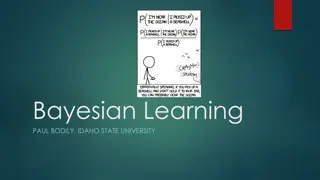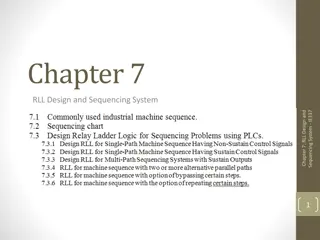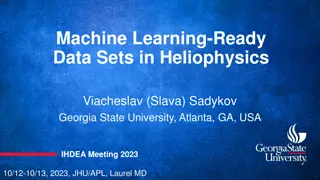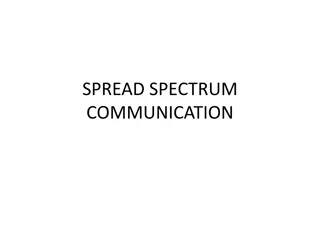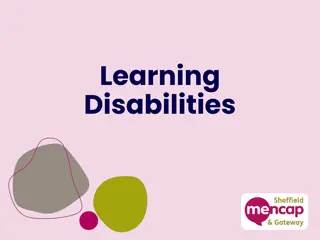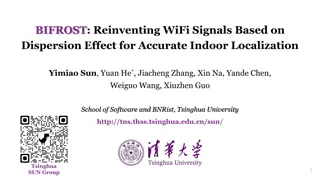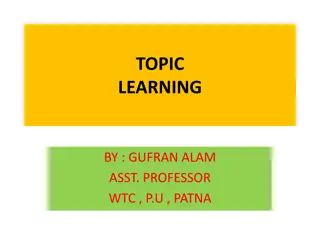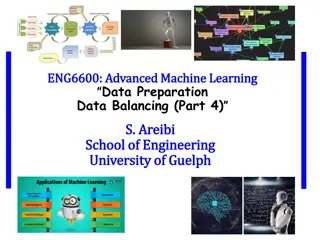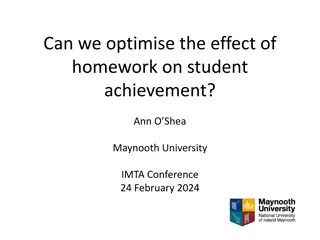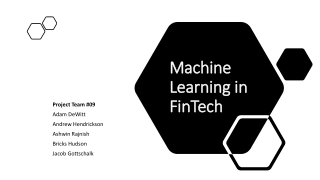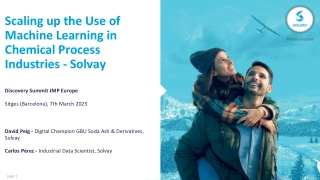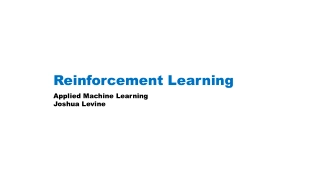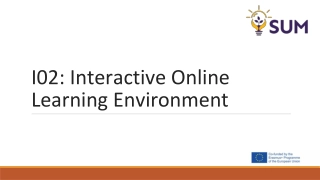Understanding Audio and 1D Signals in Machine Learning
Explore the world of audio and 1D signals in machine learning through topics such as representing sound with frequencies, deep networks for audio analysis, and the common use cases of 1D time series data. Learn about signal analysis, frequency spectra, and the contributions of Jean Baptiste Joseph Fourier to signal processing.
Download Presentation
Please find below an Image/Link to download the presentation.
The content on the website is provided AS IS for your information and personal use only. It may not be sold, licensed, or shared on other websites without obtaining consent from the author. Download presentation by click this link. If you encounter any issues during the download, it is possible that the publisher has removed the file from their server.
Presentation Transcript
Audio and 1D Signals Applied Machine Learning Derek Hoiem
This class: Audio and 1D signals Representing sound with frequencies Deep networks for audio Other 1D time series
1D time series problems are common Audio Speech recognition, sound classification, source separation Stock prices, vibrations, popularity trends, temperature,
Example: Temperature at Logan Airport Trends can occur at multiple time scales Smoothing and differencing are important forms of analysis https://www.mathworks.com/help/signal/ug/signal-smoothing.html
How are 1D signals different from other problems? 1. Signals are often periodic, and can be analyzed in terms of slow and fast moving changes 2. Signals can have arbitrary length, and can be analyzed in terms of recent data points (windows) or some cumulative representation
Jean Baptiste Joseph Fourier (1768-1830) ...the manner in which the author arrives at these equations is not exempt of difficulties and...his analysis to integrate them still leaves something to be desired on the score of generality and even rigour. had crazy idea (1807): Any univariate function can be rewritten as a weighted sum of sines and cosines of different frequencies. Don t believe it? Neither did Lagrange, Laplace, Poisson and other big wigs Not translated into English until 1878! But it s (mostly) true! called Fourier Series there are some subtle restrictions Laplace Legendre Lagrange Slide: Efros
A sum of sines Our building block: Asin( x + ) Add enough of them to get any signal f(x) you want!
Frequency Spectra example : g(t) = sin(2 f t) + (1/3)sin(2 (3f) t) = + Slides: Efros
Frequency Spectra = + =
Frequency Spectra = + =
Frequency Spectra = + =
Frequency Spectra = + =
Frequency Spectra = + =
Frequency Spectra 1sin(2 k = = ) A kt 1 k
Sound Sound is composed of overlaid sinusoidal functions with varying frequency and amplitude Digital sound is recorded by sampling the sound signal with high sampling frequency Fig src Fig src Slide content source: TDS
Spectrogram Sound is a series of sinusoids with varying amplitudes, frequencies, and phases Fig src Total amplitude tells us how loud the sound is at some point, but that s not very informative The spectrogram tells us the power in each frequency over some time window Slide content source: TDS
Mel Spectrograms Humans perceive frequency on a logarithmic scale, e.g. each octave in music doubles the frequency Mel scale maps frequency to human perception of pitch Mel scale records amplitude in decibels (logarithmic base 10) Slide content source: TDS
Mel Spectrogram Slide content source: TDS See this link for code to generate Mel Spectrogram
Audio Classification 1. Pre-process into Mel Spectogram Image 2. Apply vision-based architectures to classify Data augmentation can include time shift on audio wave and time/frequency masking on spectrogram Details and code here: https://towardsdatascience.com/audio-deep-learning-made-simple-sound-classification-step- by-step-cebc936bbe5
Audio to Speech (ASR) Process data, similar to audio classification MFCC processes Mel Spectrogram with DCT to get a compressed representation that focuses on speech-related frequencies Content src
ASR Deep network with vision architecture extracts features Recurrent network (e.g. LSTM) models each output at time t as dependent on the features at time t and latent representations at time (t-1) and/or (t+1) Feature Map Windows LSTM Based on Baidu s Deep Speech model, as described here
ASR Each time step predicts a probability for each character Character probabilities are decoded into text output Based on Baidu s Deep Speech model, as described here
ASR A challenge of ASR is temporal spacing between characters Audio is sliced uniformly and fed into RNN RNN predicts character probabilities, merges repeated characters, and removes blanks Based on Baidu s Deep Speech model, as described here
Other details Loss based on likelihood of true character sequence Error is often reported as Word Error Rate or Character Error Rate A language model and/or beam search can be used to improve output As described here
Popular libraries for audio processing Librosa: https://librosa.org/doc/latest/index.html Torch Audio: https://pytorch.org/audio/stable/index.html Others: https://wiki.python.org/moin/Audio/ HuggingFace Models: https://huggingface.co/docs/transformers/tasks/audio_classification
2 minute break: jokes from ChatGPT Why did the Fourier transform go to the beach? To catch some waves! Why did the deep network refuse to listen to the audio signal? Because it was too shallow! Why did the audio to speech recognition system get depressed? Because it couldn't understand its own voice! Why did the Mel spectrogram go to the gym? To get some frequency gains! Why did the frequency go to the doctor? Because it had a sinus problem!
1D Time Series more generally Recall HW 1: predict temperature in Cleveland based on temperatures from US cities in previous days What did we do to handle this time series?
1D Time Series more generally Recall HW 1: predict temperature in Cleveland based on temperatures from US cities in previous days What did we do to handle this time series? 1. Windowed prediction: Consider temperature given five preceding days 2. Various prediction methods 1. Predict using Na ve Bayes, assuming independent Gaussian relation to previous days 2. Linear regression 3. Nearest neighbor 4. Random forest
1D Time Series more generally Recall HW 1: predict temperature in Cleveland based on temperatures from US cities in previous days What could we do to improve prediction?
1D Time Series more generally Recall HW 1: predict temperature in Cleveland based on temperatures from US cities in previous days What could we do to improve prediction? 1. Take into account other features: time of year, other atmospheric effects 2. Learn better representations, e.g. use multitask learning to regress difference of temperature for each city from previous day in a deep neural net
1D Series more generally Common to apply 1-D filter operations to smooth (e.g. 1D Gaussian) or highlight differences (e.g. difference filter [-1 1 0]) Signal is often converted into fixed length by windowing and/or padding Predictions by dynamic models can also be used as features, e.g. accounting for position, velocity, and acceleration Continuity of features can be achieved using convolutional networks, LSTMs, or other recurrent networks
Deep networks for time series forecasting The success of deep networks in vision, language, and audio is due to ability to train pre-trained models on large corpora and transfer representations to target tasks But time series problems seem quite different, e.g. predicting the price of commodities, the temperature, or the favorability polling of a political candidate Can we pre-train a model that adapts well to target time series forecasting tasks?
Zero-shot time-series forecasting, N-BEATS Train a network on diverse time series forecasting tasks 100K+ time series sequences Predict next value given preceding values Apply it zero shot to new time series forecasting tasks https://arxiv.org/abs/2002.02887 https://arxiv.org/abs/1905.10437
Zero-shot time-series forecasting, N-BEATS Input is preceding window of time series data Each block updates the forecast based on unexplained data 1. Receives delta of input and backcast 2. Applies MLP 3. Outputs backcast , the estimate of input signal 4. Outputs delta to forecast Residual connections between blocks and for each stack allow training gradients to flow throughout the network Output is total forecast https://arxiv.org/abs/2002.02887 https://arxiv.org/abs/1905.10437
More accurate than other ML and statistical models, some of which take into account seasonality and other time-series behaviors
Things to remember Audio is best represented in terms of amplitudes of frequency ranges over time Audio models use vision-based architectures on Mel Spectrograms 1D Time classification or forecasting methods often take a windowed approach, making a prediction based on data from a fixed length of time Though relatively unstudied, effective approaches for time series forecasting have been demonstrated with deep networks
Next class: ML Problems from 441 Students Identifying cracks in concrete bridges Automated ranking of applicants Predict the routes of sea vessels Predict crystallizer particle size distribution









